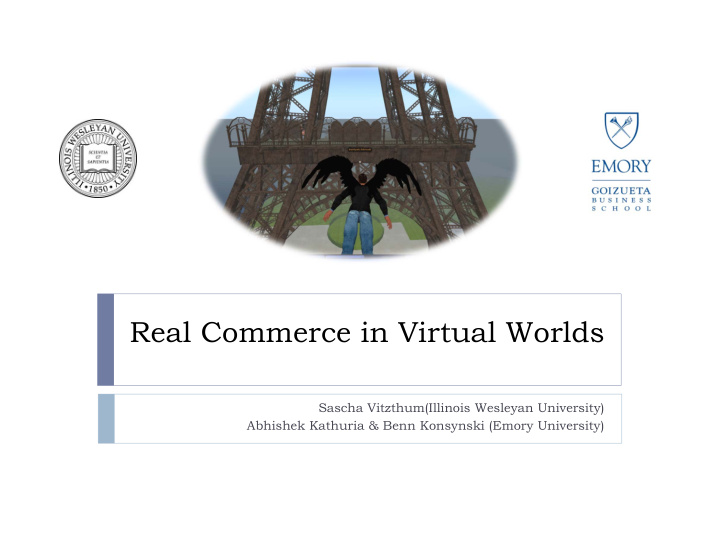



Real Commerce in Virtual Worlds Sascha Vitzthum(Illinois Wesleyan University) Abhishek Kathuria & Benn Konsynski (Emory University)
Introduction Directions in commerce practice in Virtual World (VW) environments? Similarities & differences in commerce RL and SL? Are key success factors different in VW environments? Can principles of SL commerce be transferred (“unvirtualized”) to RL? 2 Real Commerce in Virtual Worlds
Virtual World Environments Immersive, interactive, persistent online environments Provide game-like, role-playing, concurrent experience Consist of online personas, creations of online personas, spaces and their interactions 2-D Immersive Massive (early 90’s) (mid 90s) (late 90’s) • ImagiNation Network • Active Worlds • Second Life • The Palace • There • Entropia Universe 3 Real Commerce in Virtual Worlds
Linden Lab’s Second Life Extensive world, designed on real world template Avatars placed under almost realistic environmental constraints Residents retain intellectual property rights over in-world creations Commercial activities facilitated by Linden Dollars (L$) Freemium model: premium membership permits ownership of virtual land transaction fees charged for currency exchange 4 Real Commerce in Virtual Worlds
In-world Economy & LL Governance Q3 2005 • Popularity of gathering spots – monetization attempted through subscription & advertisements Q4 2005 • Bypass of gathering spots allowed – land price upheavals Q4 2006 • Exchanges of virtual goods & commissioned real estate development fuel economic growth Q1 2007 • Huge success of virtual gambling Q3 2007 • Gambling ban - bank runs leading to first recession in SL Q1 2008 • Interest payment ban – SL banking industry ceases to exist Q1 2009 • Real world institutions establish significant SL presence • Rise of in-world service providers with agile, adaptive structures & expertise in dealing with SL idiosyncrasies Q2 2009 5 Real Commerce in Virtual Worlds
VirtualCircle After three years, VC has 3 real employees 3600 virtual employees & sales affiliates 5000 customers each day nearly $200,000 in yearly profits Strategic Options Expand into new SL business lines Venture into other VWs Commence RL operations 6 Real Commerce in Virtual Worlds
VC Evolution Virtual Retailing • VirtualCircle founded by Stuart • Vending systems & virtual sales O’Brian in Q1 2006 affiliates enabled through customized software • Revenues through developed land • Retail stores to sell virtual sales, gathering spot advertising, • No selling costs: commission furniture, clothing & accessories & commercial spot lease fees based affiliates • No in-house design: products • Increasing competition & • Project based in-world employees offered on commission basis oversupply of land • Leasing & labor costs not scalable Land Virtual Sales 7 Real Commerce in Virtual Worlds
Real to Virtual Commerce? Real Retailing Virtual Online Selling Retailing Virtual Virtual Vending Retailing 8 Real Commerce in Virtual Worlds
Teaching Strategy 9 Real Commerce in Virtual Worlds
Target Usage Virtual Worlds Future Business Entrepreneurship Models • Introduction • Skills to manage new technology • Underlying • Virtual Micro technology • Agility & adaptability Economies in dynamic • Challenges associated foreshadow future of environments turbulent business with interfacing with new technological environments • T emporary work platform relationships • Changes in work associations, • Leverage of social leveraged by new ICT networks for economic success 10 Real Commerce in Virtual Worlds
Teaching Schedule Section Time Introduction to SL 10 mins Stakeholder Analysis (SL & VC) 20 mins Discussion of SL as technological & economic platform 20 mins Recommendations & predictions for VC 10 mins Key takeaways & theory 10 mins 11 Real Commerce in Virtual Worlds
Theoretical Underpinnings The Dawn of the E-Lance Economy (Malone, T.W., & Lautbacher, R.J. 1998, HBR) How underlying VW technologies enable new organizational forms & work mechanisms Shaping Strategy in a World of Constant Disruption (Hagel, J., Brown, J.S., & Davison, L. 2008. HBR) VC as a platform participant & its future strategic options Additional complementary readings, videos & links available at case companion website at www.emory.edu/BUSINESS//VirtualWorldBiz/TN/ 12 Real Commerce in Virtual Worlds
The Dawn of the E-Lance Economy Impacts of ICT enabled economy over 20 year horizon SL technology & market standards enable temporary companies Project based assembly of skills Managers sense environmental changes & assemble capabilities Self managed teams VC an example the norm in the digitally enabled future 13 Real Commerce in Virtual Worlds
Shaping Strategy in a World of Constant Disruption Platform creation & shaping strategies for providers & participants: framework to analyze SL and VC Three participant roles: Influencer, Hedger, Disciple VC an Influencer, with SL specific capabilities & influence Interoperability will enable optimum Hedger strategy 14 Real Commerce in Virtual Worlds
Key Takeaways First mover advantage & Virtual technological leverage of knowledge global labor market Knowledge of SL economic mechanisms & stakeholder behavior Constantly changing, agile business model suited to hypercompetitive & turbulent SL environment 15 Real Commerce in Virtual Worlds
Discussion Questions? Cases in Progress T eleradiology in the Clouds HyperCollaboration T ools (Wave, 12spirits, Mendeley) Kaneva – Attracting developers to a platform Please contact us for supplemental materials! Reading supplements, videos & online activities available at www.emory.edu/BUSINESS/VirtualWorldBiz/TN/ 16 Real Commerce in Virtual Worlds
Questions Assess the virtual economy of SL! What are the main economic, technology and policy characteristics? Assess VC’s business! What are the key success drivers? How have the businesses lines evolved? What are your recommendations for Stuart? How can VirtualCircle expand business in the future? 17 Real Commerce in Virtual Worlds
Recommend
More recommend